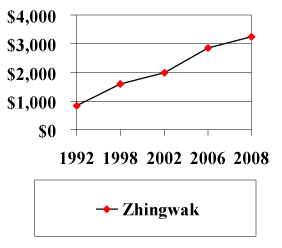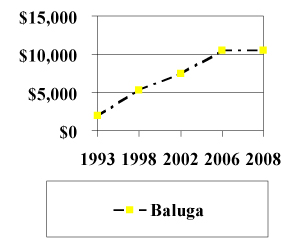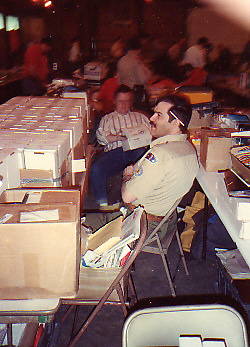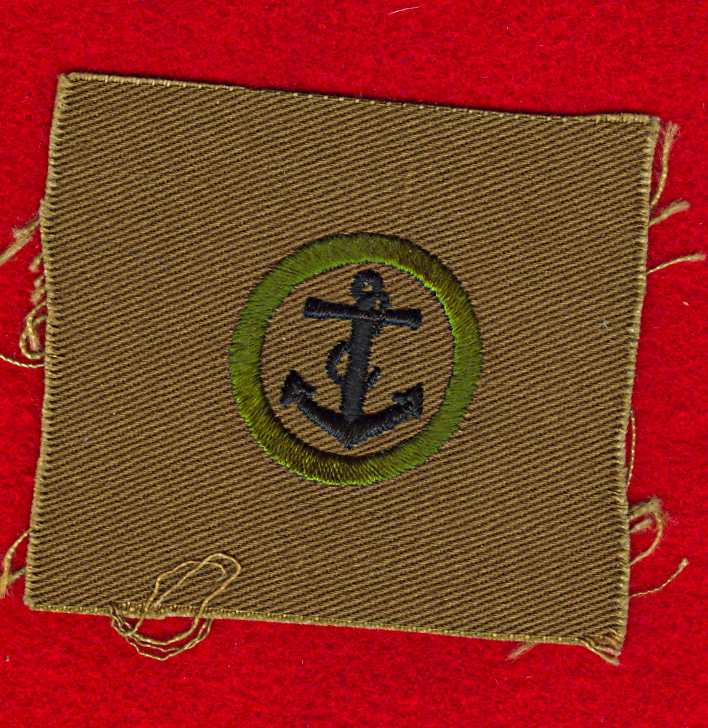|
2009 Year in Review covering 2008
By Roy More, ISCA #0020L
Lets look at hobby happenings in 2008 and some thoughts on 2009 and ahead.
Collecting and Economic Recessions
Well it became official in November of 2008 that the US was in a recession that actually started in December, 2007. I have been helping collectors buy and sell Scout patches since 1986 which means I and my team have seen multiple recessions over the years. When asked by people outside of the hobby "How are things?" my response continues to be the same. I tell them, "The names may change but the interest and thus value hasn't."
I was touching base last fall, in the middle of the financial freeze-up in October, with a long-time Scouter. He and I worked together on several Woodbadge courses and NOAC staffs. He had helped me out at national TORs in prior years but nothing for the past several years. He asked how things were going but before I could answer he said, "Let me guess." He then rattled off that "Prices are down for the common, low-end items. Stable for middle tier. And up for top-tier items." I told him he nailed it although I added that top-tier means not just scarcity but condition. He pointed out that that is how it has always been with solid collectibles, not just Scouting collectibles.
Most stock markets across the world were down 40%+ during 2008 but not Scouting collectibles. Now this is not to compare Scouting collectibles with stock investments but there can be very wide price swings within liquid investments as there can be in collectibles. With stocks, one can get a price for them at just about any time. This is not true for collectibles. Like real estate, it can take time, sometimes a long time, for a piece to find a match between seller and buyer. But also, like real estate they don't make vintage patches any more. Although this is not totally true with the issuance of fakes and reproductions but the statement is technically true.
At the Dallas Trade-o-ree I gave a presentation concerning the economy and patches. It included the following two charts of price history for two key Order of the Arrow flaps: 352 Zhingwak F1 and 538 Baluga S1. These were not randomly selected. They are two of the better OA first flaps. But they have come up from time to time over the years as there is some, albeit limited, availability which gives consistent data points.


Even though we were and are in challenging economic times Scouting memorabilia continues to change hands with new, record prices in some cases while other items sold for less than they did the year or two prior.
Passings
Again the hobby lost some of its long time collectors in 2008. Two that come to mind were Dr. Dave Leubitz of Ohio and John Hannabas of Virginia.
Dave Leubitz had not been very visible on the collecting scene for a decade or more but his influence on the hobby will continue for decades. He passed way in September after a long illness. Dave was "The Trader."

I called Paul Myers to pass on the news of Dave's passing. We discussed some of the contributions he made to the hobby. He was an editor of the Trader magazine. Certainly at the time, it was the most influential hobbyist newsletter. Actually some think we probably need something like that again even in the age of e-mail and the internet. Dave also resurrected Forest Reynold's Blue Book of OA issues. This listed what issues lodges had but we only had the detail of twill (F) vs. solid (S) flaps or odd-shapes, pies and arrowheads. We didn't have the detail as to border color, edge, background, etc.. Still it was better than anything else out there. Later it was Dave's collection that was the basis for Arapaho II that Al Hoogeveen compiled. This was the OA images before there was oaimages.com. EVERY serious collector had a copy of Arapaho II just to be able to identify issues and know what you had. If it wasn't for Dave's collection, we wouldn't have had the book that moved this hobby to a whole new level.
We handled the sale of Dave's collection after he made his original transaction with Dr. Horne and Bill Topkis. Dr. Morley at the time observed that he thought Dave had the best middle-issue OA collection ever put together. It still took us years to work through its sale given its size. Its probably fair to say that most collections these days have a piece that came through Dave's hand.
John Hannabas and his wife Beatty were regulars on the TOR circuit throughout the country. John also sponsored the Roanoke TOR and several National Jamboree TORs along with Conrad Auel and Steve DeWick. I am sure his passion for the hobby brought many into the fold. We will miss their regular presence at the Pittsburgh TOR always right inside the door to the left.
EBay Listings Declined
Ebay continues to be a significant influence in the hobby but it continues to wane. Listing volumes are down. Bidding activity is sporadic although the passion from bidders is not. Policies eBay put in place to fix problems in non-collectible offerings were carried over to our area that had a negative impact.
Ebay realizes, in the big picture, it is not growing as fast as e-commerce is growing. Thus, in the minds of its managers and the stock market, it is losing market share. They see that the solution is to become more like other sites specifically Amazon which are fixed price sellers rather than peer-to-peer auctions.
System changes they made last year that hurt our area included: "Best Match" search that really was more like "Worst Match"; paperless payments that make it seem like all payments have to be made with Paypal or a credit card; and discouraging traditional auctions over fixed price listings. Some of these efforts were an attempt to combat fraud which certainly affects Scouting collectibles but in more cases than not it discouraged, or made it not as easy, for honest sellers/buyers to make transactions. We heard many complaints from collectors that we passed up to our eBay contacts but we were not going to be able to get their policies changed. I am expecting continued struggles with eBay as they try to figure out what they want to be.
As eBay was like a daily sell-o-ree its decline means that a greater value of transactions are happening off of eBay. Five years ago, I estimate that our firm had 80% of its sales through eBay. Now it is more like 50% and declining. The majority of high-value, ultra rare items were typically privately placed. Now this is even more so. As a result, "price watching" on eBay is mis-leading. John Pannell's OAImages.com web-site is a good price resource for OA items but the site doesn't know what it doesn't know nor can it reflect condition or accuracy. We are looking at some solutions through our web-site but there are several needs for accurate price realized data beyond what is seen in eBay.
Category review
The following are my general impressions about the interest level in major segments of our hobby.
OA
Name collecting, i.e. collecting a patch from each lodge not just each lodge number, is a general trend now in OA collecting. Right now there may be only one or two complete name collections in the country. Currently there may only be two complete first flap collections. There are between fifteen and seventeen complete 'traditional number sets'.
OA continues to be the highest valued area of Scouting memorabilia. For merged lodge issues there is a general closing of the values between the restricted issues and the common issues post lodge merger. As prices move up the "provenance", i.e. background and documentation, of a patch and any certification are becoming increasingly important in the higher valued items. Also, condition is increasingly important as those willing to pay top dollar are demanding top conditioned patches.
The year ended up with some resolution of making available to the general hobby significant portions of the Morley-Topkis Collateral Collection. This has been described as the best collection not in a museum and will continue to come up, and thus affect the hobby throughout 2009.
First flaps - Continue to be solid. Over the past three years the hobby has significantly absorbed five major collections in this area. The availability of the rare ones of these is limited. There are new collectors adding to their collections. As a result, there were new high prices realized in 2008. Not necessarily for all items and some modern rarities have retreated in price but certainly a solid area still in the hobby.
Lodge Activity Patches - Sizzling, although it depends upon the part of the country.
Lodge Neckerchiefs - Selectively hot, again depends upon the lodge and the issue. This area saw several record prices or transactions for rare neckerchiefs. In March, a previously unknown neckerchief from Aheka 359 sold for $14,665, the most ever paid for any non-patch neckerchief.

Record price for a silkscreen OA N/C -$14,665
NOAC - Cool. Some interest in the early items but that's about it. If collectors looked at the attendance numbers for the early NOACs/National Meetings they would find some were smaller than some section conclaves are today.
Section Conclave Patches - Cool except for Southern Region.
First Issues and Wabaningo issues - Again selectively hot while others can be down right cold.
Membership cards, Sashes, and Ceremony Books - Up and coming. Some membership cards can bring surprising prices, in excess of $100 per. I would have thought there would be more interest in OA sashes but neither Terry Grove's nor Paul Myers' work in this area has yet to catch on with collectors. Vintage felt Vigil sashes remain undervalued.
Council and Shoulder Wear
CSPs - Stable. Generally most items can be found for low book but occasionally auction prices were above high book. This is still the most broadly collected area of Scouting memorabilia. There continues to be fakes of recent issues from overseas manufacturers. Some are of limited issue, fundraiser pieces. Others are for common pieces that end up being offered for more than the Council price. Makes no sense. It certainly taints this area of collecting. It still is very easy to begin collecting these. Many of the first issues from 35 years ago can be found for less than $5.
JSPs - Interest has faded but will probably start to resume again at the end of 2009 in run-up to the 2010 jamboree.
Red and Whites (and other pre-CSPs) - Stable. Some bargains occasionally slip through at auction but in general these items bring a solid price. Community strips continue to be actively collected as state collectors have added them to their needs list. These new collectors are finding how hard it can be to track some of these down. For the pre-RWS state strips, there is virtually no supply other than the occasional piece on a uniform. Sea Scout strips, other than for the most common, continue to be undervalued. State strips of the all colors are drying up.
Council Patches - Solid to increasing. This has been a sleeper area for quite some time with a few collectors quietly but consistently acquiring these items. They fit in with this category but there has not been a reference work for this area since Al Hoogeveen's Arapaho from the 1970s. A couple of collectors began some private work on this but it has not been published. Because of the tie-in to shoulder wear or other council items and collectors extending the depth of their collections as they are narrowing the breadth of their collecting interests these will likely pick-up.
Insignia
This was a quiet year for adult insignia. Same old, same old. No availability of vintage items. Any good pieces were quickly picked up. Even the more common items such as Scoutmaster and Assistant Scout masters from the 1930s have dried up and are not often seen.
One sleeper area that changed hands was what was probably the largest collection of Sea Scout flagship patches of approximately 30 pieces. These were from the late 1930s to 1940s. They were somewhat analogous to Quality Unit patches but for Sea Scout ships and were much harder. To this day it is still not known what all was issued. Most collectors in this area just list all the possibilities and then check off what they can find. These items can range from a few hundred dollars to several thousands a piece.
Merit badges
On the surface 2008 may have been perceived as a quite year but in reality this was a record setting year. There was at least one top-five collection that changed hands with a value above $100,000. There was also a record price achieved for a single merit badge. Chris Jensen of Streamwood Company handled an auction of the square, black anchor Seamanship merit badge with a final price of $34,000. This was the first Seamanship merit badge. It was pictured on the 1914 BSA calendar. There may be only two or three known specimen to have survived. It was replaced by a later teen's era red anchor, a very scarce item in its own right, and then another redesign again in red. Although the high price is eye popping for us the more interesting piece of information was that there were still five (5) bidders at $10,000 or more. Prior to this the high priced pieces were the Pigeon Raising on square or spider design of Insect Life both in the $6,000+ range.

Record price for a merit badge - $34,000
Squares - Somewhat flat. The greatest interest is for teens issues and the very rare badges but there is a difference between bid and ask. The teens remain under collected. That is, only a slight increase in the collectors in this area could have a profound impact on price. There are currently less than ten (10) serious collectors of teen square merit badges and yet none are anywhere near complete.
Fine twills and wide crimp - Also cooled from prior years. Many wide crimps offered though are squares cut and folded down. Many are hard to authenticate as wide crimps. There seems to be less interest in going after the fine twills although some recent sales showed solid, consistent prices with prior years.
Narrow tan crimped - Soft.
Khaki crimped - Stable.
Rolled edge twills/green border cloth backs - Solid. Still very affordable and some are short run issues. There does not appear to be much supply of many of these and demand is strong whether from collectors pursuing all merit badges or collectors replacing the ones they earned in the 1960s and 1970s.
Green border, plastic backs - Solid and getting stronger. We did not realize this until we started getting questions about some of our offerings but collectors are now pursuing the type of plastic back. There are currently three: white plastic, blue plastic and the newest "Scout Stuff" plastic back. There is not a lot of price differences, yet. But there are and will be discovered some sleepers in the transition. Specifically there have been some redesigns of merit badges that occurred shortly before the Scout Stuff marked backs came out. The sleepers will be new designs but non-Scout Stuff plastic back.
Youth Rank
Eagles - Solid/flat. We have multiple standing offers to buy for T.H. Foley, the first, eagle medals in good condition at $10,000 or more. Stable to record prices occur for Type 1 Eagle patches, especially in Sea Scout colors.
Silver Awards - Solid
Exploring - Cool. Extinct memorabilia such as this seems to have a limited following. Air Scout memorabilia seems to be the exception as there is very little supply and continued interest for some of our hobby's most distinctive insignia.
Combined ranks - Sizzling for the lower ranks and odd positions. Flat for the more common issues such as First Class and Second Class Patrol Leader. There are some of these pieces that have come out that have not sold at their asking price even in the $200 - $300 range although condition matters. But many of the rarest combinations, such as Tenderfoot Patrol Leader Bugler, have not been seen publicly for years and could easily bring a price of ten times the price of the more common pieces in this series.
World Jamborees
The passion continues for this area but most major collectors have filled-in the main items. High value items continue to sell given time. Collectors continue to fill-in, particularly for the pre-1955 jamborees, items used at or in conjunction with the early World Jamborees. Other than for the obscure items there was little demand from the World Jamborees of the past twenty years.
BSA National Jamborees
We are in what is a long stretch for BSA National Jamborees so interest seems flat. This would have been a jamboree year but was pushed out for the 100th anniversary of the BSA. Still there was at least one major collection that privately changed hands for a mid-five figure price. High quality 1935 and 1937 patches are hard, and expensive, to find. The availability of high quality condition patches has dried up significantly and we are not yet to 2010. These patches eased up a few years ago as particularly BSA professional staff members who trained at Schiff Scout Reservation in the 1940s passed on. They were able to buy excess patches for $0.10 each. Most bought one or two but that was it. Their estates have turned over and thus their supply. The shoulder patches and tabs from these early jamborees continue to command high prices with obscure regions bringing $500 - $750 each. It was not long ago that these were $75 to $125.
Camps
Felts - Sizzling to solid.
Embroidered - Sizzling to solid There is a geographical bias. That is, the same vintage and scarcity of patch can command a widely different price depending upon what part of the country it is from. Not all felt camp patches will bring $20 or even $10. Many of these are scarcer than the comparable OA patch even though the OA patch could bring four or five figures. But remember that the highest single piece sold at the Parlett estate auction was over $3,000 for a single camp patch.
High Adventure Bases
Philmont - Solid. Philmont continues to be one of the signature facilities and programs of the BSA. The participation levels continue to be solid. This creates a large pool of potential collectors. There are more program patches than ever before being issued. Although this creates new items to collect their initial prices can be skewed by a few passionate collectors. What happens is that after a few of the most senior, most complete collectors in this area fill-in a new piece, the price can drop. But what also happens enough times is that if you do not get it when it first comes out or have a chance at the item, you may never see it again for years. There were no, new reports of major fakes in this area but that continues to be a potential risk for modern issues.
Sea Base - Limited action. I expect that this will pick-up as it is an active, popular program but its design and facilities limit the annual number of participants and thus the inherent collector base.
Region 7 and Region 10 - Limited collecting interest. Region 7 seems to have more of a following that Region 10. The more recent items, from the 1970s, are the more valuable items other than the earliest pieces. As knowledge of these bases passes, collecting interest wanes.
Maine Matagammon - Limited collecting interest. It is a similar trend here as with Region 7 and Region 10. The greatest interest is from the collectors nearest these bases. They are more likely to see the items and to have had a connection to the base.
Region patches
Original 12 - Stable. This is another area where there was an 'off the radar' sale of major importance. The Paul Myers' collection was sold in a single sale to a single collector. The youngest of these items are at least 35 years old. What has been lost over time was that most of these had limited, restricted use by only regional professional staff or national contingents. Within this area there's increasing interest in regional event patches and the ephemera, items issued to staff members such as cuff-links, tie-bars, etc.. This follows a trend towards collectors filling in their collections. It does make for a more interesting presentation than just an array of patches. Many of these items are not that expensive but are a challenge to track down. We have found though that we have to explain to many collectors that there were originally twelve regions and then six.
Old 6 - Solid, more interest than expected.
Current 4 - Soft, not much history yet.
General Projections for 2009
This year has the National Order of the Arrow Conference. Again there will be an ISCA sponsored pre-NOAC trade-o-ree. But, for the first time this will be an official part of NOAC itself with the TOR continuing through the first day of NOAC registration. This is due to exceptional efforts from the ISCA leaders and friends on the OA National Committee. It should be a great time for all and is likely to open up to many the breadth of this hobby.
Speaking of NOAC itself, the OA Museum displays will be a must see for the hobbyist. This was one of the highlights of the 2006 NOAC at Michigan State. Besides great lodge collections the Las Vegas International Scouting Museum displayed memorabilia from the founders and Bill Topkis displayed his OA/pre-OA lodge pin collection. There was no where else in the country that someone could see such extensive collections in one place. I expect that this year's exhibit should be on everyone's schedule.
There will be a significant number of contingent items. But we are seeing many items being used as fund raisers for contingents with prices well above cost. I am doubtful these will sell as well as some hope. Hopefully it will damp down what is likely to be a bumper crop of new issues going into the 100th anniversary of the BSA in 2010.
In speaking of new issues, the Consumer Product Safety Improvement Act (CPSIA) approved last August is a stealth issue that will confront all Scout councils. Current policy out of the BSA is requiring full certification at the strictest levels. This affects anything made after November 10, 2008. It will increase lead times for orders of anywhere from 7 to 8 weeks because of required testing and increase the cost due to required testing. Contingents that do not get their order in almost at the time of this article may not get their items and if they get items in that are not certified they may find their Scout Executive having them destroyed for fear of the financial liability due to the penalties under this legislation and whistle blower protections.
As always, have fun and enjoy this great hobby.
|